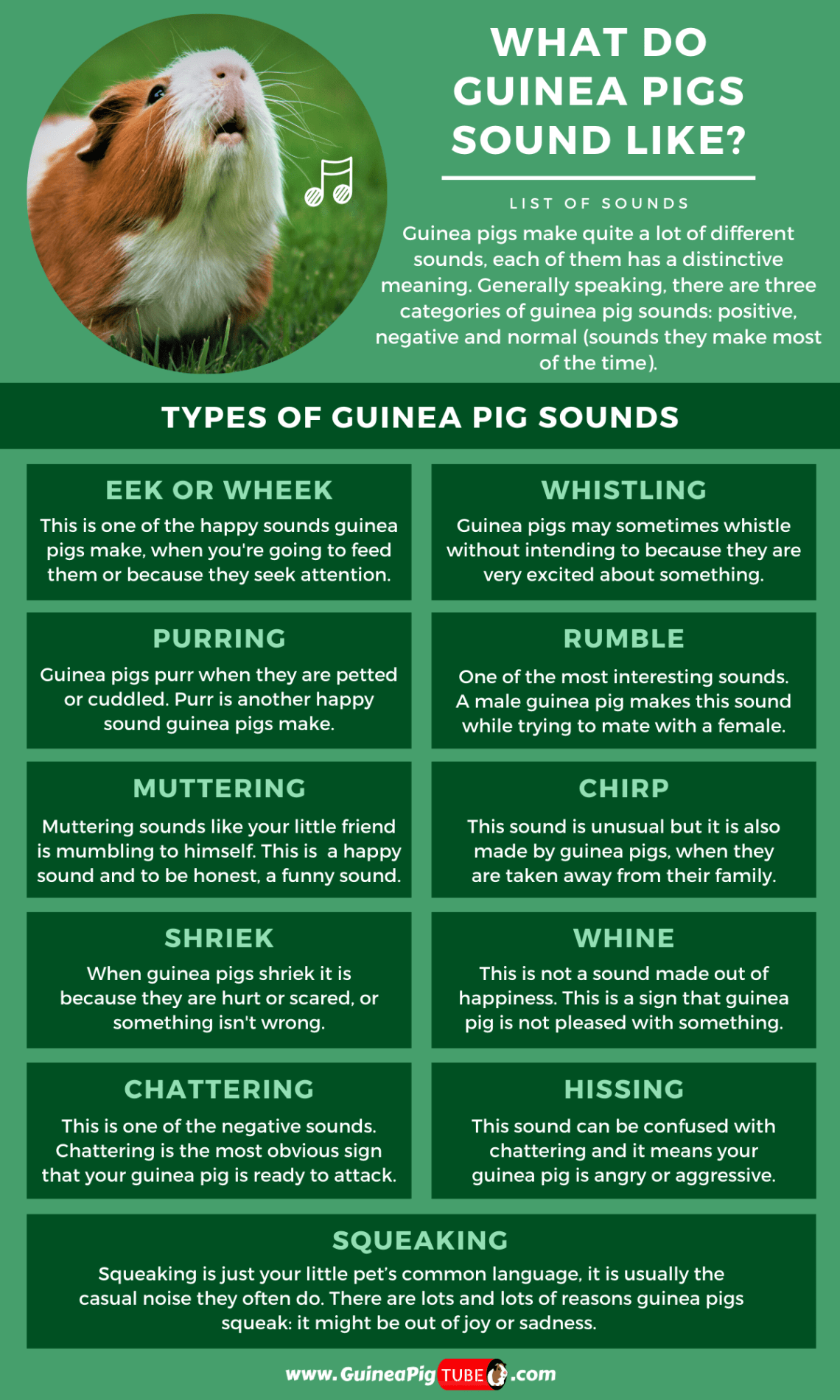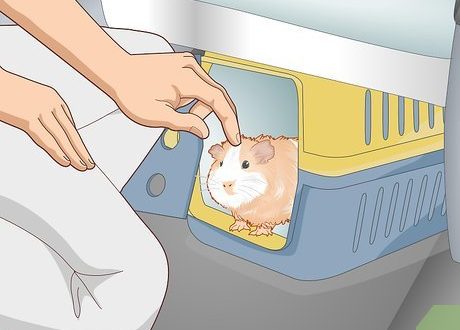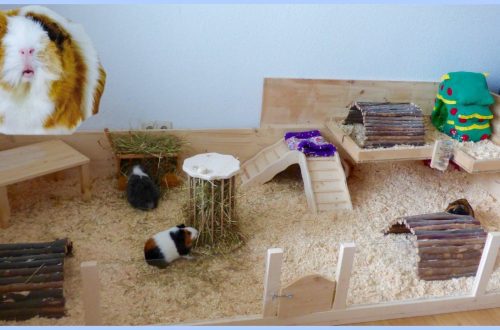
Guinea pig behavior
Guinea pigs are sociable animals, they feel best in the company.
For a pig contained in the singular, only a person can be a friend, and he is obliged to give her quite a lot of attention so that she does not feel lonely.
Guinea pigs learn quickly and are ideal pets for children.
Guinea pigs are sociable animals, they feel best in the company.
For a pig contained in the singular, only a person can be a friend, and he is obliged to give her quite a lot of attention so that she does not feel lonely.
Guinea pigs learn quickly and are ideal pets for children.
Guinea pigs are absolutely not aggressive and not dangerous to humans.
Keeping more of these small, lovable rodents makes it possible to get acquainted with their behavior in the herd, allows you to observe a variety of customs that can only appear when the pig feels safe surrounded by its relatives.
The pig does not bite and does not fight with the enemy. To unfamiliar surroundings, smells, sounds – everything that seems unsafe to her – she reacts with a stampede or absolute immobility. Under natural conditions, this behavior often saves the lives of these rodents.
These meek animals show aggression exclusively in relation to individuals of their own species. It can be found between gilts competing for food or a place to rest. Mothers, after the end of the lactation period, sometimes drive away the cubs, the same get angry when the milk becomes insufficient.
Often the cause of aggression is an excessive concentration of animals forced to stay together in a small space. Examples of aggressive behavior include mutual hair-plucking and eating what is left in the mouth. Displeasure also manifests itself in the form of a sharp turn and a jump directed towards the enemy. The turned pig crouches, opens its mouth, often snapping its teeth in warning and bristling its scruff.
The most formidable conflicts come between two males fighting for dominance over the herd. Two males, chattering, clicking their teeth, raising their hind legs alternately, circle one around the other. If neither of them refuses this introductory game, they begin to jump on each other and bite. Refusal to fight even at the stage of the “war of nerves” does not always save the capitulated person from being bitten. For the victor may pursue the vanquished and seize with his teeth those places which he can reach.
Under natural conditions, bloody conflicts happen very rarely because the weaker male has somewhere to run away and where to hide. When breeding in a confined space, incidents of this kind can be unsafe.
Females, as a rule, tolerate each other well, but even here there is a certain hierarchy: the leader puts things in order among her same-sex relatives and babies. All females take care of the health and development of offspring. In the first week of life, the babies are fully supported by the female. If one cub wants to eat, he can get milk not only from his mother, but also from another nursing female. If the baby is alone, he begins to make a loud, plaintive squeak until the mother hears him: she approaches him, making rumbling sounds, sniffs, licks his muzzle, and then puts him in his place. From the second week, the babies become more and more attached to the male, who wean them from their mother’s care, starting from the third week, the mother stops feeding them with milk.
Guinea pigs are absolutely not aggressive and not dangerous to humans.
Keeping more of these small, lovable rodents makes it possible to get acquainted with their behavior in the herd, allows you to observe a variety of customs that can only appear when the pig feels safe surrounded by its relatives.
The pig does not bite and does not fight with the enemy. To unfamiliar surroundings, smells, sounds – everything that seems unsafe to her – she reacts with a stampede or absolute immobility. Under natural conditions, this behavior often saves the lives of these rodents.
These meek animals show aggression exclusively in relation to individuals of their own species. It can be found between gilts competing for food or a place to rest. Mothers, after the end of the lactation period, sometimes drive away the cubs, the same get angry when the milk becomes insufficient.
Often the cause of aggression is an excessive concentration of animals forced to stay together in a small space. Examples of aggressive behavior include mutual hair-plucking and eating what is left in the mouth. Displeasure also manifests itself in the form of a sharp turn and a jump directed towards the enemy. The turned pig crouches, opens its mouth, often snapping its teeth in warning and bristling its scruff.
The most formidable conflicts come between two males fighting for dominance over the herd. Two males, chattering, clicking their teeth, raising their hind legs alternately, circle one around the other. If neither of them refuses this introductory game, they begin to jump on each other and bite. Refusal to fight even at the stage of the “war of nerves” does not always save the capitulated person from being bitten. For the victor may pursue the vanquished and seize with his teeth those places which he can reach.
Under natural conditions, bloody conflicts happen very rarely because the weaker male has somewhere to run away and where to hide. When breeding in a confined space, incidents of this kind can be unsafe.
Females, as a rule, tolerate each other well, but even here there is a certain hierarchy: the leader puts things in order among her same-sex relatives and babies. All females take care of the health and development of offspring. In the first week of life, the babies are fully supported by the female. If one cub wants to eat, he can get milk not only from his mother, but also from another nursing female. If the baby is alone, he begins to make a loud, plaintive squeak until the mother hears him: she approaches him, making rumbling sounds, sniffs, licks his muzzle, and then puts him in his place. From the second week, the babies become more and more attached to the male, who wean them from their mother’s care, starting from the third week, the mother stops feeding them with milk.
In a cage or aviary for guinea pigs, there is no escape route, so the responsibility for the peaceful coexistence of animals lies with you. Pay attention to the following.
For young males, when they reach puberty, that is, no later than 4-5 weeks, other owners should be found. This is necessary not only to avoid skirmishes, but also to prevent uncontrolled further reproduction.
If the male is defeated in the struggle for the dominant place in the family, he must immediately be placed in another enclosure, otherwise he will wither away, since there is no longer a place for him in the family.
A young, castrated male placed with a group of females will probably not be able to immediately establish himself as a host. The situation will change only with time, when he grows up and will surpass females in size and weight.
A guinea pig that shuns its peers has probably had no contact with other guinea pigs since an early age, which means it lacks a sense of community with the group and therefore finds it very difficult to get along with its brethren.
If you want to place a group of guinea pigs in a new cage with other guinea pigs, you can safely do so. A separately kept guinea pig is more difficult to hook up with several animals, among which she will have to get along. In addition, several animals need a more spacious cage.
In a cage or aviary for guinea pigs, there is no escape route, so the responsibility for the peaceful coexistence of animals lies with you. Pay attention to the following.
For young males, when they reach puberty, that is, no later than 4-5 weeks, other owners should be found. This is necessary not only to avoid skirmishes, but also to prevent uncontrolled further reproduction.
If the male is defeated in the struggle for the dominant place in the family, he must immediately be placed in another enclosure, otherwise he will wither away, since there is no longer a place for him in the family.
A young, castrated male placed with a group of females will probably not be able to immediately establish himself as a host. The situation will change only with time, when he grows up and will surpass females in size and weight.
A guinea pig that shuns its peers has probably had no contact with other guinea pigs since an early age, which means it lacks a sense of community with the group and therefore finds it very difficult to get along with its brethren.
If you want to place a group of guinea pigs in a new cage with other guinea pigs, you can safely do so. A separately kept guinea pig is more difficult to hook up with several animals, among which she will have to get along. In addition, several animals need a more spacious cage.
A female dissatisfied with courtship often defends herself from an annoying male. Her defensive reaction is that she, having doused the insolent with a stream of urine, takes to flight. She succeeds because the male lingers for a moment to sniff himself. A few energetic jumps of an angry female directed in his direction can also discourage the male from flirting.
A sign of reconciliation is the opening of the most delicate parts of the body, those parts that are easiest to hurt. Many other animal species behave in a similar way. The pig stands on fully extended paws and throws its head back, opening the muzzle and neck. Such postures are taken by individuals subject to the influence of their stronger comrades, and by males in relation to their partners.
A female dissatisfied with courtship often defends herself from an annoying male. Her defensive reaction is that she, having doused the insolent with a stream of urine, takes to flight. She succeeds because the male lingers for a moment to sniff himself. A few energetic jumps of an angry female directed in his direction can also discourage the male from flirting.
A sign of reconciliation is the opening of the most delicate parts of the body, those parts that are easiest to hurt. Many other animal species behave in a similar way. The pig stands on fully extended paws and throws its head back, opening the muzzle and neck. Such postures are taken by individuals subject to the influence of their stronger comrades, and by males in relation to their partners.
Hearing in guinea pigs is just wonderful, it is he who is of paramount importance in the perception of the environment.
Vision in guinea pigs is also very well developed. As a result of the experiments, it was found that guinea pigs distinguish colors, primarily yellow, red, green and blue.
Guinea pigs have a perfect sense of smell. They are good at smelling. When greeting, they sniff each other, paying special attention to the anus and ears. They mark their territory with odorous substances, urine and secretions of the glands. One should not be surprised when a pig, let into its tidy dwelling, walking along it, rubs its back against the bedding. This is a way to mark the territory with the secretion of the glands located near the anus. Males also use the glands located on the sides of the body. With a secret released from them, they mark the members of the herd and objects located above the floor (flooring).
The organs of touch in guinea pigs are located in the antennae growing around the muzzle. They help the animals navigate in the dark and avoid obstacles.
Hearing in guinea pigs is just wonderful, it is he who is of paramount importance in the perception of the environment.
Vision in guinea pigs is also very well developed. As a result of the experiments, it was found that guinea pigs distinguish colors, primarily yellow, red, green and blue.
Guinea pigs have a perfect sense of smell. They are good at smelling. When greeting, they sniff each other, paying special attention to the anus and ears. They mark their territory with odorous substances, urine and secretions of the glands. One should not be surprised when a pig, let into its tidy dwelling, walking along it, rubs its back against the bedding. This is a way to mark the territory with the secretion of the glands located near the anus. Males also use the glands located on the sides of the body. With a secret released from them, they mark the members of the herd and objects located above the floor (flooring).
The organs of touch in guinea pigs are located in the antennae growing around the muzzle. They help the animals navigate in the dark and avoid obstacles.





